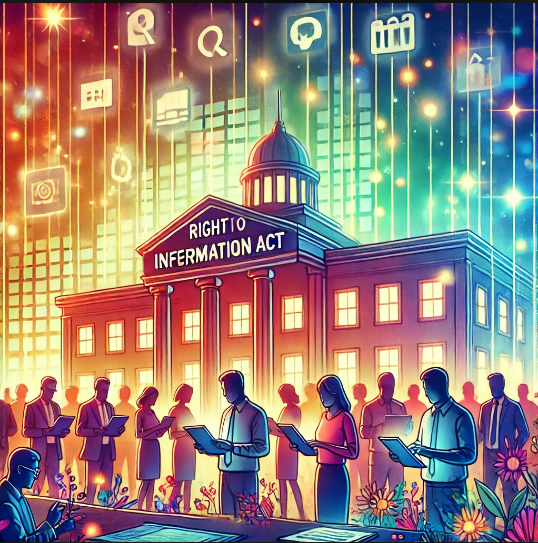Introduction
The Right to Information (RTI) Act, enacted in 2005 in India, is a landmark legislation that empowers citizens by giving them access to government records and proceedings. While its primary aim is to ensure transparency, it also fundamentally redefines the concept of accountability in governance. This article explores how RTI enhances citizen empowerment and simultaneously strengthens accountability mechanisms within public institutions.
Citizen Empowerment Through RTI
The RTI Act is a tool that enhances democratic participation by enabling citizens to question and seek information from government authorities. The following are key ways in which RTI empowers individuals:
- Transparency in Governance:
- Citizens can access government records, policies, and decisions.
- Reduces secrecy in administration and promotes openness.
- Strengthening Democracy:
- Encourages participatory governance where citizens are informed about state actions.
- Fosters an informed electorate that can hold elected representatives accountable.
- Protection Against Corruption:
- RTI enables whistleblowers and activists to uncover instances of corruption and maladministration.
- Citizens can demand explanations for fund allocations and expenditures.
- Improved Public Services:
- By questioning inefficiencies, citizens push authorities to improve services such as healthcare, education, and infrastructure.
- Strengthens grievance redressal mechanisms by ensuring that complaints are addressed.
- Promotes Social Justice:
- Helps marginalized communities access welfare schemes and benefits by acquiring necessary information.
- Prevents discrimination and arbitrary decision-making by authorities.
RTI and Redefining Accountability
While RTI is a powerful tool for citizens, its deeper impact lies in redefining accountability. Traditional forms of accountability relied on hierarchical reporting and internal audits, whereas RTI introduces a direct form of accountability between the government and the people.
1. Making Government Answerable to Citizens
Before RTI, public authorities were primarily accountable to higher administrative bodies and legislative oversight committees. The RTI Act shifts this paradigm by making government departments directly answerable to the public. This new form of accountability ensures:
- Responsiveness from officials to public inquiries.
- Reduction in bureaucratic complacency and inefficiency.
- A proactive approach in disclosing information to minimize public scrutiny.
2. Enhancing Administrative Efficiency
The fear of public scrutiny compels officials to maintain accurate records and make sound decisions. As a result:
- Government departments become more organized and diligent in documentation.
- Officials become more cautious and responsible in their actions, reducing arbitrary decision-making.
3. Bridging the Gap Between Citizens and Government
RTI strengthens the relationship between the state and citizens by:
- Providing a legal framework for information exchange.
- Encouraging public participation in governance.
- Reducing distrust between government authorities and the people.
4. Strengthening Institutional Accountability
Public institutions, such as local municipalities, state departments, and public sector undertakings, are required to disclose information under RTI. This means:
- Institutions must maintain transparency in financial dealings.
- Officials are held responsible for their actions and decisions.
- Systemic corruption is curbed through external checks by civil society.
5. Judicial Oversight and RTI
Courts have upheld RTI as a fundamental right under Article 19(1)(a) of the Indian Constitution. Judicial interventions ensure:
- Governments cannot arbitrarily deny information.
- Accountability measures are upheld through legal enforcement.
- Public Interest Litigation (PIL) cases benefit from RTI disclosures.
Challenges in Implementing RTI for Accountability
Despite its significance, the RTI Act faces several hurdles that limit its effectiveness:
- Bureaucratic Resistance:
- Many officials are reluctant to share information, fearing exposure of inefficiencies or corruption.
- Delayed responses and excessive redaction of documents reduce RTI’s effectiveness.
- Misuse of RTI:
- Some individuals file frivolous RTI applications for personal vendettas.
- The overload of applications burdens public information officers (PIOs), slowing down the process.
- Threats to Whistleblowers and Activists:
- RTI activists exposing corruption often face threats, intimidation, or even violence.
- The absence of adequate whistleblower protection laws discourages transparency.
- Limited Digital Accessibility:
- Rural and marginalized communities struggle with digital filing and tracking of RTI applications.
- Lack of awareness about RTI limits its reach and impact.
- Exemptions and Restrictions:
- Certain categories of information (e.g., national security, privacy concerns) are exempt under RTI.
- The scope of RTI is sometimes curtailed by amendments that dilute its effectiveness.
Conclusion
The Right to Information Act is a transformative tool that empowers citizens by providing them access to government information. However, its impact extends beyond transparency—it fundamentally redefines accountability by shifting the power dynamics between the state and the people. By making public officials answerable to citizens, RTI strengthens democratic governance, enhances administrative efficiency, and fosters a culture of responsibility. However, for RTI to fully realize its potential, implementation challenges must be addressed, ensuring that both transparency and accountability remain core pillars of governance.
Thus, the RTI Act is not merely about empowering citizens; it is a revolutionary mechanism that reshapes governance by embedding accountability at its very core.




